Taking an environmentally sensitive approach to pest management
"Black" Wheat
Published: June 16, 2015
Wheat harvest is underway or rapidly approaching in most areas of the state. Foliage diseases such as Septoria leaf blotch did occur in low levels across much of the state. Stripe rust was severe in some areas. Bacterial leaf streak has been showing up the last few weeks. Fusarium head blight or scab was perhaps more widespread and severe than predicted. But now the questions seem to focus on black discoloration on wheat heads, black heads on wheat plants or black wheat plants.
There are several possible explanations for black heads on wheat plants or for a black discoloration on portions of wheat heads and these are described in the following paragraphs. At this point in the season black mold growth on leaves, stems and heads of wheat plants is usually the result of secondary or saprophytic fungi growing on senescing plant tissue. The excessive rainfall and number of overcast days the last three weeks have been very favorable for the development of these black molds or sooty molds on maturing wheat.

Black wheat plants
The black heads due to loose smut are most obvious as heads emerge from the boot and for several weeks after that. The kernels on infected heads are replaced with masses of powdery black spores. So the heads have a very distinct black, powdery appearance. These spores are eventually dislodged by wind and rain, so later in the season the smutted stems are less evident and only the bare rachis will be left.
Septoria leaf blotch was present in the lower canopy of many fields this year. It didn’t seemed to move up in the canopy to the flag leaf in many fields but with the continued precipitation and high humidity in some areas if may have developed on wheat heads. On the heads dark brown to black blotches may develop. Stagonospora nodorum may also cause leaf lesions but is usually more common on heads- again causing dark blotches on glumes of part or all of the head.
Bacterial streak or black chaff is a bacterial disease that produces symptoms on both leaves and heads. Water-soaked lesions may develop on young leaves. These expand into reddish-brown to brownish-black streaks on the leaves. Glumes and awns show brown-black blotches or streaks. Fungicides are not effective against bacterial streak or black chaff so the use of resistant or tolerant varieties and crop rotation are the main management options. Again, wind driven rains, rain in association with hail and heavy rains can spread this bacterial disease through a wheat field quite rapidly.

Black wheat heads due to sooty molds
Another likely cause of black wheat heads or black discoloration of wheat heads and plants is sooty molds. Sooty molds are a number of saprophytic or weakly parasitic fungi which grow on senescing or dying plant tissue. Alternaria, Cladosporium, Aureobasidium and other species are frequently found on these discolored or black plants. Since the affected plants may have a sooty appearance these fungi are sometimes called sooty molds. These sooty molds or secondary fungi tend to develop on plants when wet or humid weather occurs as the crop is maturing or if harvest is delayed because of wet weather. Typically these fungi come in on plants that are shaded, undersized, weakened or prematurely ripened and on senescing foliage. Plants that are lodged or that have been stressed by nutrient deficiencies, plant diseases (ex. portions of wheat heads damaged by Fusarium head blight or plants weakened by stripe rust) or environmental conditions may be more severely affected. Although many of these fungi produce dark or black mold growth, the color of the mold growth can range for dark or black to olive green or even pink to white.
On wheat these secondary fungi tend to develop the heads or portions of the heads but may also occur on leaves and stems of wheat plants. These black molds also tend to produce large quantities of spores. It is not uncommon to see dark clouds of spores around combines moving through fields with high levels of black mold or sooty molds. At this time there is nothing that can be done except to harvest fields as soon as practical and store grain under proper storage conditions.
Subscribe to receive similar articles sent directly to your inbox!
REVISED: September 30, 2015